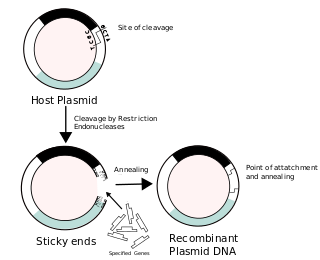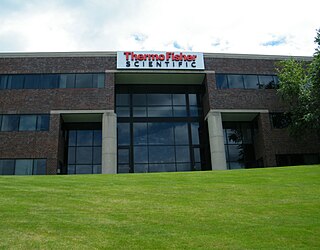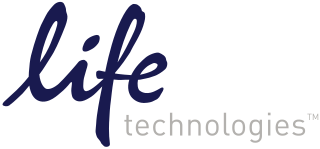
In genetics, complementary DNA (cDNA) is DNA synthesized from a single-stranded RNA template in a reaction catalyzed by the enzyme reverse transcriptase. cDNA is often used to clone eukaryotic genes in prokaryotes. When scientists want to express a specific protein in a cell that does not normally express that protein, they will transfer the cDNA that codes for the protein to the recipient cell. In molecular biology, cDNA is also generated to analyze transcriptomic profiles in bulk tissue, single cells, or single nuclei in assays such as microarrays and RNA-seq.
In genetics and biochemistry, sequencing means to determine the primary structure of an unbranched biopolymer. Sequencing results in a symbolic linear depiction known as a sequence which succinctly summarizes much of the atomic-level structure of the sequenced molecule.
Affymetrix is now Applied Biosystems, a brand of DNA microarray products sold by Thermo Fisher Scientific that originated with an American biotechnology research and development and manufacturing company of the same name. The Santa Clara, California-based Affymetrix, Inc. now a part of Thermo Fisher Scientific was co-founded by Alex Zaffaroni and Stephen Fodor. Stephen Fodor and his group, based on their earlier development of methods to fabricate DNA microarrays using semiconductor manufacturing techniques.
RiboGreen is a proprietary fluorescent dye that is used in the detection and quantification of nucleic acids, including both RNA and DNA. It is synthesized and marketed by Molecular Probes/Invitrogen of Eugene, Oregon, United States. In its free form, RiboGreen exhibits little fluorescence and possesses a negligible absorbance signature. When bound to nucleic acids, the dye fluoresces with an intensity that, according to the manufacturer, is several orders of magnitude greater than the unbound form. The fluorescence can be detected by a sensor and the nucleic acid can be quantified. The presence of protein contaminants in the sample of nucleic acids to be tested does not make significant contributions to the absorbance, and thus allows for the addition of deoxyribonucleases to the protocol in order to degrade DNA, in the instances where one is only interested in detecting or quantifying RNA.

Recombinant DNA (rDNA) molecules are DNA molecules formed by laboratory methods of genetic recombination that bring together genetic material from multiple sources, creating sequences that would not otherwise be found in the genome.
The Alexa Fluor family of fluorescent dyes is a series of dyes invented by Molecular Probes, now a part of Thermo Fisher Scientific, and sold under the Invitrogen brand name. Alexa Fluor dyes are frequently used as cell and tissue labels in fluorescence microscopy and cell biology. Alexa Fluor dyes can be conjugated directly to primary antibodies or to secondary antibodies to amplify signal and sensitivity or other biomolecules.

Promega Corporation is a Madison, Wisconsin-based manufacturer of enzymes and other products for biotechnology and molecular biology with a portfolio covering the fields of genomics, protein analysis and expression, cellular analysis, drug discovery and genetic identity.
Sigma-Aldrich is an American chemical, life science, and biotechnology company that is owned by the German chemical conglomerate Merck Group.

New England Biolabs (NEB) produces and supplies recombinant and native enzyme reagents for the life science research, as well as providing products and services supporting genome editing, synthetic biology and next-generation sequencing. NEB also provides free access to research tools such as REBASE, InBASE, and Polbase.

Thermo Fisher Scientific Inc. is an American supplier of scientific instrumentation, reagents and consumables, and software services. Based in Waltham, Massachusetts, Thermo Fisher was formed through the merger of Thermo Electron and Fisher Scientific in 2006. Thermo Fisher Scientific has acquired other reagent, consumable, instrumentation, and service providers, including: Life Technologies Corporation (2013), Alfa Aesar (2015), Affymetrix (2016), FEI Company (2016), BD Advanced Bioprocessing (2018), and PPD (2021).
Fermentas was a biotechnology company specializing in the discovery and production of molecular biology products for life science research and diagnostics. Since 2010, Fermentas has been part of Thermo Fisher Scientific.
Applied Biosystems is one of various brands under the Life Technologies brand of Thermo Fisher Scientific corporation. The brand is focused on integrated systems for genetic analysis, which include computerized machines and the consumables used within them.
LGC, Biosearch Technologies, is a biotechnology company headquartered in Hoddesdon, UK. Formerly known as LGC Genomics, which acquired Biosearch Technologies, Inc. - located in Petaluma, CA in 2015 LGC, Biosearch Technologies has also recently acquired Douglas Scientific, located in Alexandria MN (designs, manufactures, tests and provides service support. Continually expanding their genomics portfolio offerings, ranging from high quality PCR reagents, custom genotyping assays, genomic services, gene editing and NGS services, as well as workflow solutions for DNA sample preparation and downstream processing

Genesee Scientific Corporation, a life science products company, is a leading supplier of products to global life science research markets. With thousands of products available, its markets include pharmaceutical and biotechnology companies, medical research institutions, research and development laboratories, universities, colleges and secondary education institutions, hospitals, reference labs, and quality control/process control laboratories.

Life Technologies Corporation was a biotech company founded in November 2008 through a US $6.7billion merger of Invitrogen Corporation and Applied Biosystems Inc. The joint sales of the combined companies were about $3.5 billion; they had about 9,500 employees and owned more than 3,600 licenses and patents.

The Qubit fluorometer is a lab instrument developed and distributed by Invitrogen that, among other applications, is used for the quantification of DNA, RNA, and protein.
Pierce Biotechnology Inc. is the ultimate origin of a number of products and product lines in the Thermo Fisher Scientific research and development division, "Thermo Scientific Pierce Protein Biology." The company from which this division originated, the Rockford, Illinois-based Pierce Chemical Company (PCC) was founded in 1948 when Alan Pierce assumed active management of a company known as Midwest Extraction, which focused on isolating chlorophyll from alfalfa.
Leonard Klevan is a businessman and scientist in the fields of biochemistry and biotechnology. As of 2009 Klevan has assumed the position of president of the Human Identification Business of Life Technologies Prior to the merging of Applied Biosystems Inc.(ABI) with Invitrogen under the name of Life Technologies, Klevan acted as president of Applied Markets for ABI which produced and marketed reagent kits for forensic DNA, paternity testing and other forms of human identification as well as products for biosecurity, food/agriculture, and environmental applications.
Biomatrica is a United States-based biotechnology company, and subsidiary of Exact Sciences Corporation, that develops chemicals for ambient temperature preservation of biological materials for the purpose of expanding the availability and accuracy of medical diagnostics and research. Specifically, the company focuses on improving the stability of biological materials, such as DNA, RNA, proteins, cells from patient samples used in research, and diagnostic testing reagents. Company scientists have developed alternatives to existing preservation technologies, such as cold storage and lyophilization (freeze-drying), to prevent degradation of perishable biological materials. Biomatrica's technologies are used in applications such as pre-analytic sample collection, diagnostic assays, biobanking, forensics, and basic research.
The T7 expression system is used in the field of microbiology to clone recombinant DNA using strains of E. coli. It is the most popular system for expressing recombinant proteins in E. coli.








